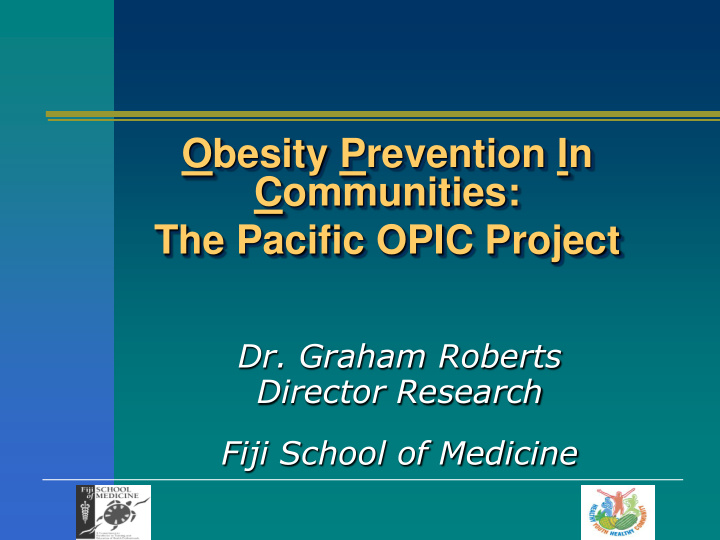



Obesity Prevention In Communities: The Pacific OPIC Project Dr. Graham Roberts Director Research Fiji School of Medicine
Introduction Rising levels of obesity in school-age children are causing increasing concern . Preliminary result of OPIC baseline data informs us that 22% of students (n= 7169) are either overweight or obese (OPIC DATA) Food/Diet and Physical Activity are key Risk Factors to obesity. School Canteens play active role in providing healthy food choices for school children. Important for the schools to increase the healthiness of food sold in school canteens Parents to limit the amount of money given to students to spend on unhealthy foods
Healthy Youth Healthy Community (OPIC Fiji) Project background/Aim Intervention settings Selected study results Baseline study Socio-cultural study School Audit study
Baseline Data - Methodology 18 secondary schools in the island of Viti Levu in Fiji participated in the study 7237 students participated in the study o Gender - Females 53%, Males 47% o Age - More students age 13-16yrs (84%) Ethnicity - Indigenous Fijians 43%, Indo Fijians – o 52%, Others – 5% Self-administered questionnaires using Personal Digital Assistants (PDA) – completed in classroom with physical body measurements
Selected Results - baseline survey 22% of students are classified as either overweight or obese The Indigenous students were most likely to be overweight/obese (39%female; 22% male) while the Indo- Fijian students were most likely to be thin (31%female; 35%males). 30% of students reported having missed breakfast in one or more days in the last 5 school days Almost two-thirds of adolescents consumed one serve of fruit or less each day A high proportion of students (62% female and 50% male) get food for recess from the school canteen High proportion of students drank regular soft drinks and/or fruit flavoured drinks
Socio cultural In-depth interview Methods 24 males and 24 females from each cultural groups Interviewers were of the same sex as participants, spoke the same first language Interviews were recorded, transcribed and translated to English when necessary Interviews were coded into categories using N6 software, analyzed and co-analyzed.
Selected results - Socio cultural In-depth interview Messages Knowledge of healthy foods and its value and able to concentrate in school Eating pattern Knowledge about healthy foods and eating pattern not translated to practice School canteens as source of foods at recess time Spending money used to buy junk food not monitored by parents Messengers More mothers provide home messages about food than fathers Friends influence at-school choices Mixed messages – lessons learnt in classroom to that provided in school canteens
School Audit – Food and nutrition Written policy 4 schools reported having written policy to promote and support nutrition and healthy eating Canteen All operate canteen 4 schools reported they operated the canteen 6 reported it as an important source of income
Snacks sold in school canteens 4 schools reported having contracts with food manufacturer for exclusive rights to sell products at school Only 2 schools reported their school routinely promoted healthy food choices
Drinks sold in school canteens 4 schools reported having contracts with soft drink and food manufacturer for exclusive rights to sell products at school Open all day in most schools
Parents Responsibility Make sure that your children have a proper healthy breakfast everyday before school Encourage your child to have three serving’s of fruit & vegetable everyday Give your child choices of what he or she wants to eat, within the boundaries of what is healthy and affordable. Discourage children from eating unhealthy food or junk food by providing healthy snacks Invest in your children's health
Healthy School Canteens A A he healt althy hy sc scho hool ol ca cant ntee een n is is on one t e tha hat: t: provides a choice of foods for students promotes healthy food which is of good quality, tasty and affordable supports classroom teaching is appropriate for the school community is able to make some profit provides ways to encourage students to buy healthy foods
Advertising and marketing in schools School Health Notice Boards Pamphlets Posters OPIC Website Newsletter Words by mouth Assembly talks
Promotion – breakfast and lunch
Promotion of Fruits vs energy dense - snacks
Promotion of water vs sugary drinks
What Faith Based Organizations are doing
Translation to strategies Students and families were taught time management to encourage regular breakfast and prepare school lunches at home Students are actively engaged in the healthy food campaign Some school canteens are providing improved services VALUING YOUR CHILD’S HEALTH ALSO MEANS VALUING YOUR CHILD’S ABILITY TO LEARN
Acknowledgement Ministry of School Education; Management, principals, teachers; Ministry of Health; Canteen Managers; Ministry of Communities (faith- Agriculture; based); SPC (DSAP); Parents & Students. Business companies
Recommend
More recommend